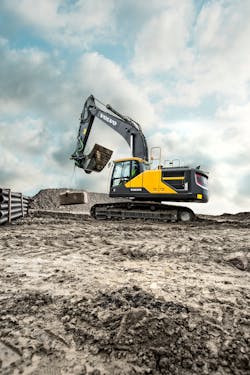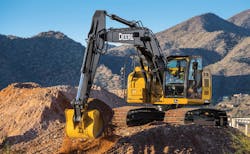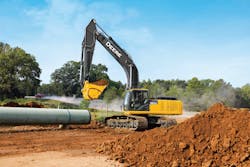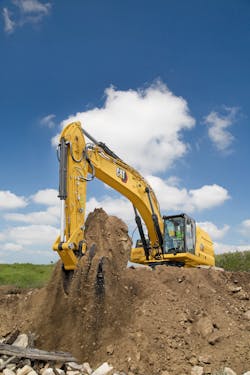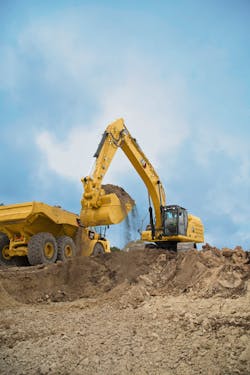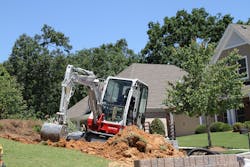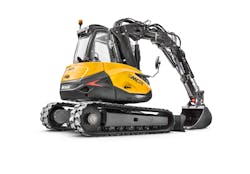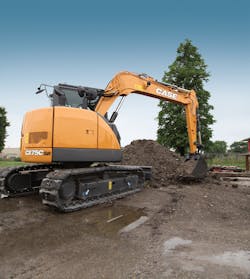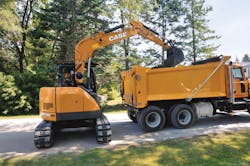Excavators come in a wide range of sizes, many suited for specific applications, while others can cover a range of activities. We decided to take a look at the most popular sizes—the models contractors choose most often—and examine the features that put them in such high demand.
Mid-Size Versatility: Volvo
Mid-size crawler excavators see the most demand at Volvo, says S.S. Kim, product manager of mid-size crawler excavators, particularly in the 45,000- to 70,000-pound range. Specific Volvo popular models are the EC220E and the EC300E.
“These are great machines when you think about the total cost of ownership,” Kim says, “because they hold their value well, are fuel-efficient when used correctly, very durable, simple to maintain, and offer technology that helps improve efficiency and productivity.”
Versatility aids productivity. With an abundance of attachments, mid-range excavators can tackle many applications. The EC220E and EC300E feature an attachment management system that allows the operator to preset hydraulic flow and pressure for up to 32 separate attachments.
Customers first consider lifting capacity and digging reach and depth on an excavator, but performance and production efficiency contribute mightily to the cost of ownership. Kim indicates that both the EC220E and EC300E offer an ECO mode that optimizes the hydraulic system to reduce flow and pressure losses, in turn reducing fuel consumption. Another fuel consumption-reducing feature is auto idle and auto engine shutdown, in which engine speed is reduced to idle and then turned off when the controls are inactive for a pre-set amount of time.
“When used correctly, work modes can save a lot of money in fuel,” Kim points out. “Many operators tend to select the highest work mode available, not realizing the task could be achieved at a much lower RPM without any loss in performance or cycle times. Choosing the right work mode can also help operators balance power and controllability.”
Volvo excavators have nine settings within four work modes: Idle, Fine (F), General (G), and Heavy (H). The G modes are excellent for digging and excavation, while the two F mode settings are ideal for fine finish grading, which needs more power and precise control. H is the heavy mode and provides maximum power while saving fuel.
Volvo’s Dig Assist machine control application adds further precision. Using sensors and GPS, it delivers accuracy in minimal time. Onboard weighing provides data for bucket loads to avoid underloaded or overloaded trucks and provide a record of the tonnage moved each shift.
ActiveCare Direct, Volvo’s telematics service, eliminates the need for an operator to decipher raw data or react to alarm codes. Instead, the dealer lets the operator know if action is necessary. “Thanks to ongoing improvements we’re making, only 1% of ActiveCare Direct-monitored units ever become critical machine-down cases,” Kim adds.
The latest model from Volvo is the EC300E Hybrid, introduced last year, featuring hydraulic hybrid technology where the boom-down motion is captured to charge an accumulator. The stored energy then drives an assist motor, lowering the torque requirement on the engine. This results in up to 15% lower fuel consumption and 12% lower CO2 emissions compared with a conventional EC300E.
Mid-Size Productivity: John Deere
North American contractors like the 21-24 metric ton and 33-40 metric ton classes because they’re good matches for the most popular customer segments, such as commercial and residential building, site development and underground, says Justin Steger, solutions marketing manager, site development, and underground for John Deere. “As job site needs change, customers demand machines that are up to the task from a performance, stability, and versatility standpoint.”
As of February 2021, JD added SmartGrade technology to the 210G LC and 350G LC. The factory-installed and calibrated SmartGrade technology offers semiautomatic machine control in a 2D or 3D system, in addition to virtual fencing capabilities and remote support. It helps operators get to grade more efficiently by providing real-time information through an in-cab monitor. The “over-dig protect” and “virtual front” features hydraulically limit the machine from digging deeper than the set point to prevent costly rework or keep the bucket cutting edge a selectable distance from the front of the machine.
The virtual ceiling, floor, swing, and wall features provide audible alerts when the machine approaches a set point, adding efficiency on a utility job site when digging to and maintaining grade with fewer grade checks.
“As grade control becomes more popular, especially in utilities and underground, John Deere recognizes that customer needs change as their businesses grow,” Steger acknowledges. Machines with factory-installed grade control technology can be upgraded later to SmartGrade through the dealer.
With margins tightening, every bit of increased production benefits the bottom line. SmartGrade technology helps operators get to grade more quickly with fewer grade checks, and allows the contractor to excavate more dirt or dig more trench more accurately, Steger explains.
Deere’s reduced tail swing 245G LC and 345G LC models for sites with limited space offer a three-pump hydraulic system for faster cycle times. Steger says, "With three pumps running three functions, and a single hydraulic pump dedicated to swing, cycle times are reduced, and multi-function performance is improved.” Because each pump runs independently, it contributes to better fuel efficiency.
Mid-Size Efficiency: Caterpillar
Caterpillar’s most popular models are also mid-size excavators. “The 336, 320, 349, and 332 are tight contenders,” muses Ryan Neal, product application specialist, Caterpillar Inc. They all have grade control with assist, payload monitoring, and other features as standard technology, so what makes one better than another?
Neal says the “widely used” 336 is easy to transport, requiring no special permit. “It’s fast, efficient, and versatile,” he says. “It can load trucks, dig deep, and do multiple jobs onsite.”
The 349 is Cat’s flagship product for pipeline and deep sewer (20-25 ft. trench boxes) work because its 4-yd. bucket moves a lot of dirt and digs deep. Their 352 does the same, but has a wider undercarriage and is taller and heavier. It offers 10% additional lift and more stability for overburden removal, loading articulated trucks, and digging deep foundations.
Neal's hoping a couple of new models will join the others on the popularity list. "The 374 is just getting launched," he says. "It can dig 32 feet deep.” The 395 was launched at CONEXPO last year. It's suitable for digging deep foundations and sewer work, mass excavation, and quarry work, such as loading stones on trucks.
The old lifting chart on the window has been digitized so the operator knows the limits and range (how far out and how far over) in which the machine can safely operate. There are an audible alarm and a visual clue. "You pick up an object and know the weight," Neal says. This helps move the most amount of dirt without overloading.
“The data is on the machine: the number of tons moved, trucks loaded, cubic yards, and volume: density, tons per hour, and tons per gallon,” Neal lists. This information helps with productivity and billing, as well as operating costs. “If you’re moving five tons less per truck, it requires more time, trucks, and fuel.”
Machine control is available on all non-GC machines from the 313 to the 395, which are also equipped with lift assist, standard 2-D grade, and an e-fence feature that keeps the bucket out of certain areas. Cat grade with assist is on most models (but not the 374 or 395 yet) and lets the operator know if he’s dug deep enough, but stays on grade, whether slope or flat. It’s most beneficial when visibility is not optimal, Neal says. “It has to do with depth perception. Can you see a 2% grade at 25 feet out?”
Despite all the high-tech upgrades, Neal says they get the most feedback about cab redesign. “Operators like the creature comforts: wider seats; flip-up armrest for egress/ingress; 10-inch touchscreen monitor; and Bluetooth for hands-free talk or music.”
Smaller-Size Maneuverability: Doosan
Contractors like the performance of Doosan’s 14- to 18-metric-ton machines, as well as 22- to 24-metric-ton excavators, including the DX140LC-5, DX140LCR-5, DX170LC-5, and DX180LC-5 in the smaller class and the DX225LC-5 and DX235LCR-5 in the next size class, according to Aaron Kleingartner, product and dealer marketing manager for Doosan Infracore North America, LLC.
He believes these are popular with contractors who may still be working in areas where a smaller crawler excavator is desired for its size, digging depth, and reach. “Another benefit of the crawler models is steel tracks for added traction, particularly if the job site is wet and muddy.”
The DX140LCR-5 and DX235LCR-5 are available with reduced-tail-swing, another advantage for tight or busy job sites or when performing road work within one lane, minimizing lane closures. The DX170LC-5 is a 17-metric-ton machine that’s easy to transport without permits and is suitable for small- to mid-size contractors doing light excavation projects such as digging residential basements or commercial building footings.
Standard rearview cameras and 7-inch LCD screens in the cab assist operators in safe maneuvering. An optional side-view camera with the choice of split-screen viewing is useful when working near structures or other equipment.
Even better is a feature introduced at CONEXPO last year: the all-around view monitor, an option for Doosan’s next-generation crawler excavators. This monitor provides an enhanced view of the job site.
To maximize fuel efficiency in specific applications, operators can engage power mode selector: four power modes for more control of fuel consumption and to match machine power to the conditions. Doosan also offers auto-idle to automatically reduce engine RPMs and save fuel when the machine is idle.
Doosan’s crawler excavators come standard with DoosanCONNECT telematics for remote monitoring of machine location, hours, fuel usage, engine idle, and error codes. Dealers can troubleshoot issues and dispatch field service technicians.
Excavators in this range can use 2D and 3D grade control systems. The 3D systems allow operators to add variable distances, such as a curved line, and are particularly helpful on complex designs like large-scale drainage projects, Kleingartner says, although they’re commonly used for digging utility trenches, excavating footings, and finish slope work. Both can eliminate the need for grade checkers.
Doosan is exploring a comprehensive control solution that would enable equipment to perform difficult work without an operator. Premiered at CONEXPO 2020, “Concept X” aims to boost productivity and safety.
Smaller-Size Ease of Use: Takeuchi
“The 3.5t excavator is the most popular size class in the industry,” states David Caldwell, product manager, Takeuchi. He says this class is popular because it can be hauled using a Class C license and 10,000-l trailer, because it requires no additional exhaust after-treatment system, it delivers better fuel economy, and it has more maneuverability, allowing it to work in more confined applications.
Efficiency, precision, and operator comfort are due to smooth, proportional hydraulic controls, Caldwell believes, adding that “a detent feature on the primary auxiliary circuit is nice when an operator is running a hydraulic attachment that requires continuous flow.”
Long arms provide a greater working range (reach/dig depth, dump height/reach) and thumb mounts simplify the installation of thumbs for applications that involve picking and placing materials and site cleanup. Standard backfill blades with float function are great for site prep and finish work, while optional angle blades are ideal for backfilling and light grading. Takeuchi offers monitors to help set attachment pre-sets and dial in specific flow rates for hydraulic attachments.
Common telematics features include geofencing and remote diagnostics that help reduce maintenance costs by capturing important data. “Utilization tracking allows the operator to see how the excavator is being used and make decisions based on this data,” Caldwell indicates. It is also used to help schedule upcoming maintenance based on run hours.
Smaller-Size Affordability: Mecalac
Mini excavators—especially the 6- to 8-ton machines—make up the largest market segment, according to Veronique Kennerson, marketing product specialist for excavators, Mecalac. That market continues to increase, and Mecalac is poised for growth with three mini crawler skid models: the 6MCR, 8MCR, and 10MCR. They also have a 15-ton model, the 15MC.
They are more affordable than bigger models and can work in the tightest of settings, making them useful for construction, sewer and water, and landscaping. “This combination of compactness and capabilities makes them a perfect tool to help customers get the job done,” Kennerson says.
Ease of use is another advantage of compact excavators, particularly in urban areas. In such environments, backhoes lack maneuverability due to their large dimensions, Kennerson indicates. “Minis are compact, easy, reliable machines that can do much more than one might think.” She advises operators to expect the strength, speed, and ease of use of a compact loader.
Crawler skid excavators can travel two times faster than any excavator in the world: up to 6.2 mph, she says. "As a compact loader, they can push and lift full loader buckets, which have much greater capacity." Therefore, contractors needn't sacrifice speed or capacity for size.
Mecalac’s 8MCR is an 8t machine that has the compactness of a 2t machine but uses the buckets of a 10-12t excavator. “It’s the perfect ratio between weight and performance, and the perfect fusion between a loader and an excavator,” Kennerson believes.
She considers Mecalac’s monitors and interfaces to be very intuitive, with few buttons. The boom cylinders coupling functions allow the operator to use a two-piece boom as easily as a mono boom, she contends.
Smaller-Size Power: Case
Case minimum-swing-radius excavators in the 12- to 25-ton class are their most popular models, according to Nathaniel Waldschmidt, product manager, Case Construction Equipment, probably because they provide digging and lifting power in a smaller footprint. “The compact counterweights and modified boom placement result in highly maneuverable and powerful excavators that are easy to transport and ideal for highway work and other tight job site conditions.”
Their D Series excavators achieve faster cycle times thanks to a new electronically controlled pump, a larger control valve, and multiple sensors, all of which enhance the Intelligent Hydraulic System to actively manage the machine's hydraulic power, for added digging strength and lifting power that makes them capable of applications typically reserved for larger machines.
The Intelligent Hydraulic System consists of four systems: Boom Economy Control reduces RPMs by using gravity during boom down and swing; Auto Economy Control lowers RPMs during idle; Swing Relief Control reduces hydraulic power at the swing start; Spool Stroke Control adjusts hydraulic pressure during digs.
In addition to power, the compact excavators offer precision and fuel efficiency. They also provide a spacious cab with numerous operator comforts including a 7-inch widescreen monitor.
Technology
To enhance the performance of any size or brand of excavator, Trimble offers aftermarket, scalable solutions that provide 40% productivity gains due to less fuel usage, wear on the machine, and material wasted, according to Cameron Clark, industry director, machine control.
Trimble’s solutions allow an operator to do in-field design. For example, on a drainage project, they can create a trench around a hill or object, Clark envisions. Operators can create alignment, smooth slopes, or create footing designs.
Trimble’s system can also automate a machine so that all the operator has to do is pull the stick to control the boom and bucket. “It makes a big difference in productivity and accuracy,” Clark says. It can improve operator performance—as much as 30% faster and 100% more accurate. This enables an operator to do more with a smaller machine because it adds versatility. An excavator can now do the fine grading a dozer used to do, or the finishing a motor grader used to do.
Augmented reality can add accuracy and eliminate a person in the trench. A camera on the cab shows the buckets and a model overlay so the operator sees what he’s building in real-time. “You can see what needs to be done onsite—what cuts and fills—or you can use it as a survey tool,” Clark explains.
Earthworks, a payload management system, optimizes the loading of trucks. Clark lists the benefits: improved accuracy and safety; savings of fuel, manpower, and materials; less wear and tear on the equipment; and less time to get to grade, without waiting for grade checkers or subcontractors.
Pulse, Trimble's complete telematics solution, "goes way beyond preventative maintenance," says Radika Raj, senior product manager, telematics. Providing visibility—where the machine is if it’s working properly if the operator is using it right and using it better—is just the start.
“Everyone wants to know the basics: location, how the machine is much used,” Raj points out. “But they’re slowly moving to diagnostics—tracing hours, monitoring fuel consumption and fault codes for unexpected health issues.”
Beyond that, a new trend indicates that customers are putting data into costing systems, with details from purchase to usage. It can help with bids, hours, and materials. It fills in gaps, streamlines work, minimizes waste, and helps contractors make better decisions.
Choice
Big or small, or somewhere in between—the choice is up to the contractor. Whichever size is selected, excavators have become efficient, versatile, productive tools for almost any job site.

